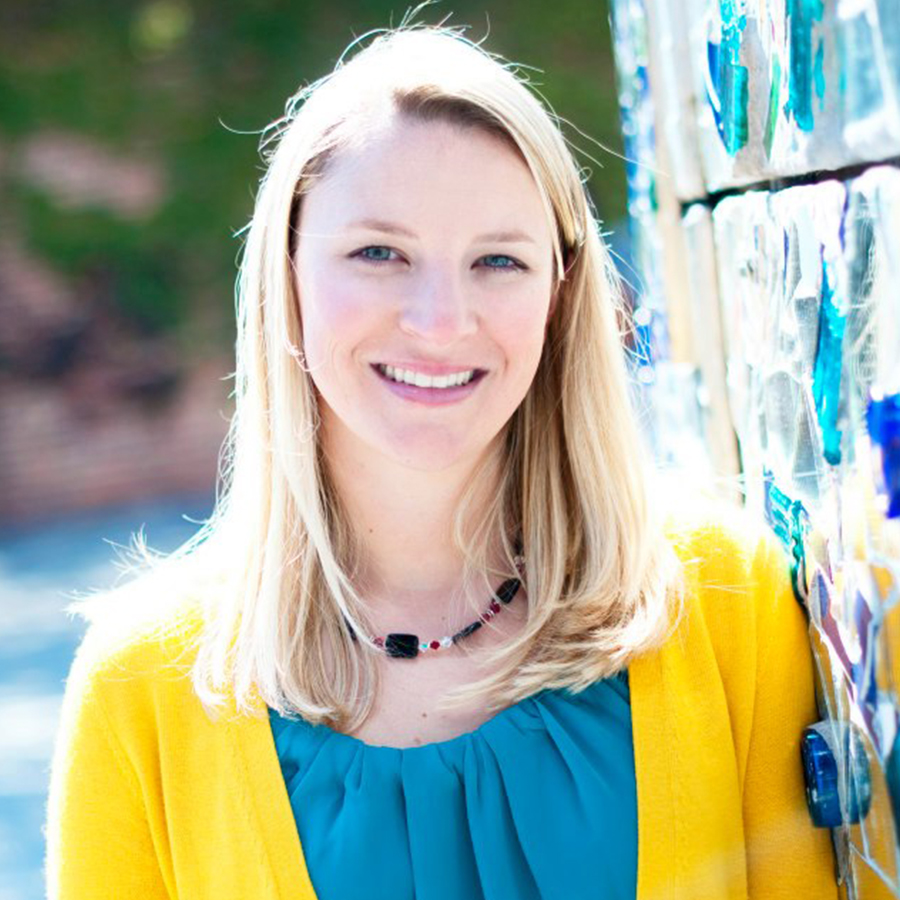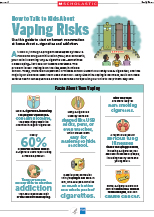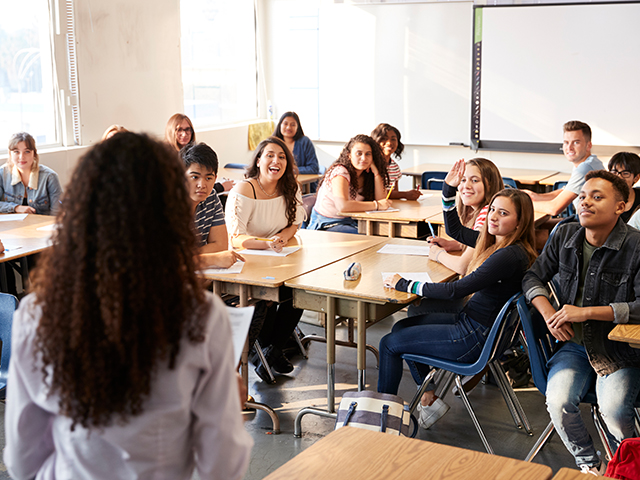Teen E-Cigarette Prevention Materials for Educators: Questions and Answers on FDA’s Collaboration with Scholastic
In 2018, FDA began a collaboration with Scholastic to create educational resources for teachers to address the e-cigarette epidemic in schools. Hear questions and answers about this collaboration from key players at FDA and Scholastic. Ashley Roberts is Chief of Strategic Communications at the Office of Health Communication and Education at FDA’s Center for Tobacco Products. Casey Mindlin is a Director of Partnerships at Scholastic. Jaclyn Canter is an Education Strategies Manager at Scholastic.
How did the collaboration between FDA and Scholastic come about?
Ashley: It began in the summer of 2018. We were hearing from teachers that they were having a hard time talking to students about the dangers of e-cigarette use, also known as vaping. At the time, we were also aware that e-cigarettes were very popular in school environments, that kids would use them in school bathrooms. Since e-cigarettes were such new and novel products, teachers were reaching out to us asking for resources to help talk to their students about e-cigarette use. We wanted to explore different ways to reach teachers with health impact messaging and our Strategic Outreach team suggested Scholastic. That team knew the reach and scope an organization like Scholastic brought to the table, and understood, right from the start, how impactful an engagement with Scholastic would be. So Strategic Outreach set up a meeting to discuss opportunities. And, boy, they were right. Scholastic explained the many different ways we could reach out to educators and the various resources that we could develop, and it evolved from there.
What skill set does Scholastic have in developing educational resources of this nature?
Casey: With reach into almost every PreK–12 classroom in America through books and educational materials, Scholastic is uniquely positioned to develop and disseminate resources featuring FDA’s e-cigarette prevention messages into classrooms. We are proud to have nearly 100 years of experience in encouraging the academic and emotional growth of children, as well as an unparalleled level of trust with teachers. We draw on this foundation to navigate nuanced discussions about high-interest topics of current concern, such as e-cigarette use among youth. After launching a program with the CVS Foundation about the dangers of tobacco, as well as developing a smoking prevention unit as part of our ongoing program with the National Institute on Drug Abuse, we already had success delivering smoking prevention messaging to classrooms in a concise, easily digestible manner.
Scholastic and FDA first collaborated last year to develop some resources for high school educators. Why collaborate again this year?
Casey: Through feedback on last year’s program, we found that classroom materials addressing e-cigarette health risks among youth yielded a big impact in the education community. Of the teachers surveyed, 99% indicated that they wanted to receive similar materials in the future. One teacher said, “It was the best overall program that I was able to find. The information was very thorough and easy to follow.” Another said, “There is hardly any information that has been available or advertised about the vaping problem that we really do have on campus. [These materials were] very informative and also gave my students statistics.” The feedback guided us to expand our efforts. Teachers are telling us that e-cigarettes are a central issue in their schools and counties—and it isn’t going to go away on its own. That’s why this year we have added print materials to last year’s digital resources and created additional lessons and resources to engage classrooms more deeply.
Why expand this content to middle school educators?
Ashley: Last year we started off with content for high-school students. We saw in the 2018 National Youth Tobacco Survey (NYTS) that high school youth use of e-cigarettes increased by 78 percent in one year, so we wanted to get some information directly into high school educators’ hands first. Our 2019 NYTS data show that 10.5 percent of middle school students have used an e-cigarette in the last 30 days.
Jaclyn: According to the 2019 NYTS, the majority of middle school and high school students reported seeing e-cigarettes used in or around school. This data is backed up by teacher feedback, such as, “Our kids are struggling with this decision (do I, don't I) in middle school. By high school, they're already addicted and have made up their minds. Middle school students are much more open to hear ideas and make decisions affecting their health.”
We want to expose middle school students to the scientific facts to combat some of the misinformation they may be hearing both in daily life and in e-cigarette marketing. At a time when they may be forming their opinions about e-cigarettes, we want them to know the dangers, especially the ones specific to the teen brain, and be prepared to say no.
What new materials are being developed, and why?
Jaclyn: This year’s program is guided by the seriousness of the epidemic, as well as by teacher feedback. Watching the explosion of teen e-cigarette use has been heartbreaking. Developing materials that help equip students to think critically and make safe choices is the core mission of this work. Last year, teachers applauded the research angle and asked us to add videos, so we have launched the following new materials in 2019:
- three new lesson plans and activity sheets for middle school, plus three for high school
- two versions of a magazine-style article for students, one for middle school and one for high school
- a digital interactive infographic that students can click through to uncover important facts about the health dangers of e-cigarettes
- a family resource sheet for teachers to send home
- We’re also providing middle school and high school kids with updated infographics on the 2019 National Youth Tobacco Survey, and with an updated infographic about e-cigarette misperceptions.
In the coming year, we’ll be adding five videos and two accompanying lessons to the mix.
We grounded the lessons in core subjects, weaving in activities that involve statistics, reading comprehension, writing, presenting, and media literacy. This approach makes it easy for teachers to weave in our e-cigarette lessons with the skills they already focus on during the school day. Simultaneously, the core subject approach gives students the opportunity to apply the math and ELA skills they are learning in school as they think critically about real problems facing teens right now—and to make choices that can help keep themselves safe.
How are we promoting and distributing these materials to schools to get the word out?
Casey: All of our materials are available online at scholastic.com/youthvapingrisks/. In support of this year’s program, we’re sending 1.35 million emails to middle and high school teachers across the country, making them aware of the new resources. We’ve also posted program announcements via our social media page on Facebook. Additionally, we’ve mailed poster-teaching guides to 50,000 middle school classrooms across the country.
How do you know developing resources like this is a helpful tool for educators? What feedback from teachers (or students/parents) did Scholastic and FDA receive last year?
Jaclyn: We were thrilled to see a strong response to last year’s program, which garnered over 90,000 downloads. Based on the feedback we received, we know these materials are valuable, both because of their format and because they are a timely resource to help teachers take action. Here is a sampling of the feedback we received from teachers last year and the key points we’ve built into this year’s materials:
- Flexible Implementation: “The materials presented the need and the info in a modern, catchy manner. It was useful if a teacher wanted to make it into a major, formal project as well as if a teacher just wanted to require a simple informative project.” —Lois, 12th grade teacher
- Inclusion of Statistics: “Without this program, I do not believe we would have been given the insight we need to pursue helping our students with vaping. It has been a valuable tool with important data that will be vital in our attempt to reach students struggling with this addiction! The timing could not have been better, as well, since we are in the process of creating a plan for assisting our students!” —Renee, 9th–12th grade teacher
- Student-Friendly: “The real facts were given in a form that they understood thus nullifying some of the myths they get from Facebook, from each other, from advertisements.” —Juliana, health educator
In response to last year’s program, teachers also requested “more facts and research work for the students”—and that’s what we’ve given them! Early reviewers of this year’s program shared, “This topic came up recently but I didn't feel like I had enough knowledge and information. This would definitely help.” —Amy, middle school teacher
Ashley: We also heard that teachers were using this material to train and educate other teachers during staff meetings. Just having this available, all you need is one or two teachers in your school to know it exists, and they may reach out to other teachers. I think this expanded suite of materials will be really helpful.
How can schools, or how do you hope schools, can use these resources most effectively?
Jaclyn: Youth e-cigarette use is a serious epidemic, and it will require all of our efforts to combat it. Our goal is to capitalize on as many trusted school relationships as possible. Teachers have unique and distinct relationships with individual students, so the more teachers involved in this effort the better. To support broad adoption of the materials, we designed the lessons to encourage usage across subject areas. Science teachers covering the human body have a great “in” for this topic, and we wanted to give a natural “in” to other teachers as well. With statistics, reading, research, presentation, or media literacy, we’ve embedded a range of skills and topics that are relevant to a range of teachers. Whether teachers launch joint projects with their colleagues or they teach these materials solo, these resources give teachers a productive pathway to alert teens that the youth e-cigarette crisis isn’t business as usual at school.
Ashley: There are also some resources about ways schools can implement different policies. We’ve linked to the American Lung Association INDEPTH program, which is a nonpunitive educational program for kids who are caught using e-cigarettes. This program can involve parents. It can involve teachers. It can be more of a support system around the student than a punitive consequence for getting caught with e-cigarettes, and the program is free.
How can parents or other individuals who work with kids use these resources, or help foster the discussion about the health consequences of e-cigarette use?
Jaclyn: We want parents and families to feel that talking to their kids about e-cigarettes is both doable and vital, so we developed a family sheet that includes information, activities, conversation starters, and cessation resources. Teachers can send it home with students or share with families directly over email.
As for further continuing the conversation, all materials are available online for free at scholastic.com/youthvapingrisks. The lessons were developed for classroom teachers, but a parent, counselor, or afterschool educator could adapt them for other contexts.
What has been most rewarding about this collaboration?
Ashley: Seeing last year’s teacher feedback was very rewarding for me. We knew that there was a knowledge gap, but to hear teachers explain how big that gap was and how thankful they were to be informed to have better conversations with their students was really great to see. To help them foster conversations and educate the kids is really rewarding. I also appreciated hearing that teachers were educating one another with these materials.
What has been most challenging about this collaboration?
Ashley: It’s very challenging to think about effective ways to educate kids while being careful of unintended consequences. We need to give kids the information but make sure it’s done in an effective way that’s not going to spark interest in youth to go explore these products.
Jaclyn: Our materials work to give students access to the facts—including the ways e-cigarette marketing can be deceptive and hook teens. But we don’t want to make it seem like “everyone is doing it” or normalize e-cigarette use in any way. So we’ve worked hard to strike a balance between giving students just enough information about e-cigarettes and marketing that can help them see through it, but without actually exposing them to ads that glamorize e-cigarettes.
What else do you think schools can do to address the youth e-cigarette epidemic?
Jaclyn: In addition to exposing students to the facts of e-cigarettes, it’s essential for schools to help equip students to deal with stress and peer pressure so they have more tools in their arsenal for breezing past e-cigarettes. Talk frankly about strategies for dealing with the stress and pressure of school and life. We think it’s great that many schools are already tackling this. We don’t want students to be desperate and seeking a coping mechanism when they’re offered nicotine—we don’t want them to feel they could use this crutch. Same goes for peer pressure: help equip students with strategies and with the self-esteem and assurance to stand up for themselves and form their own opinions. We wouldn’t want the first time a student has to think about how to say no and save face to be in the moment when they’re offered an e-cigarette.
Do you think that some children might experience withdrawal? Is there anything schools can do to address this?
Ashley: We are concerned about this. Through the Scholastic resources, we provided several e-cigarette addiction resources, and we recommend looking at those. Smokefree Teen has some really great information about quitting e-cigarettes and symptoms of withdrawal. The ALA has some helpful information available, as well. FDA also recently published a web article about what parents can do if they think their teen might be addicted to e-cigarettes.






